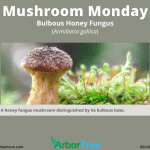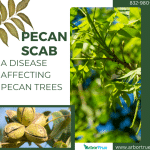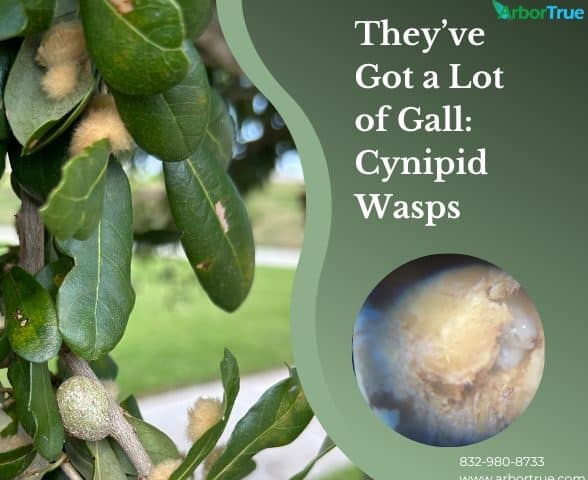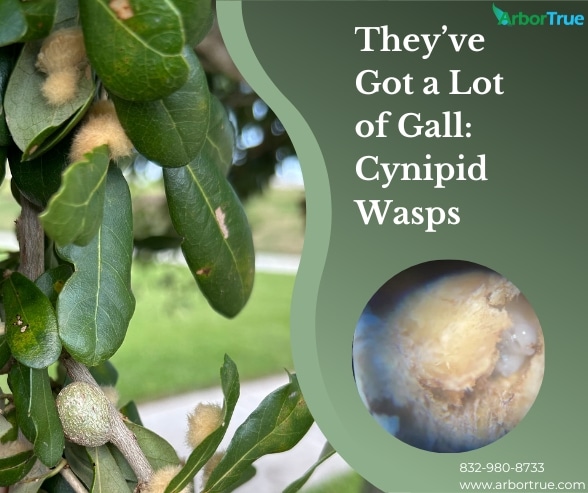
Mushroom Monday: Bulbous Honey Fungus (Armillaria gallica)
September 16, 2024
Pecan Scab: A Disease Affecting Pecan Trees
September 20, 2024
They’ve Got a Lot of Gall: Cynipid Wasps
Strange swollen growths on your oak twigs? Weird fuzzy things on leaves? What could be causing these? Learn the answer in today’s TrueTreeTalk post.
What Causes Galls on Oaks?
Galls on oaks can be caused by a number of creatures including various species of flies, mites, and aphids. The galls you may encounter most though are caused by cynipid wasps.
What are Cynipid Wasps?
Cynipid wasps is a common name for a group of gall creating insects. There are a number of species including Callirhytis spp., Acraspis erinacei, Callirhytis seminator, Andricus laniger, and Amphibolips spp. They vary in the types of galls they produce. In North America, there are more than six hundred species of cynipid wasps.
What do Galls Look Like?
Galls can vary in appearance. One kind is spherical in shape and about an inch across. They start out with a pink/brown color and are yellow/green inside. Another type appears on leaves and looks like orange hair. There are a number of other variations.
Why do Wasps Create Galls?
The wasps use the galls for food, for protection, and to have the proper temperature for their larvae. Not all cynipid wasps produce galls though. Some will live in galls made by others. They are referred to as gall inquilines.
The galls form because the plants react to hormones produced by the wasp larvae. The hormones cause the tree to grow in an abnormal way and produce the galls.
In each gall there can either be a single larva or multiple larvae. If there are multiple larvae, they are identical and come from a single egg that has split. There can be between ten and twenty identical larvae in a gall.
What is the Life Cycle of Cynipid Wasps?
Some types of cynipid wasps have an interesting life cycle. At the start, adults come out of the galls that are on the trees. This happens in December. These will all be female wasps. They will lay eggs on budding leaves without mating first (reproducing without egg fertilization is called parthenogenesis – not all gall wasps reproduce this way). The eggs will hatch at the start of spring and the larvae will grow in the tissue of the leaves. This will cause galls to form on the leaves. From these galls, both males and females hatch. These then mate and then eggs are laid by the females. The eggs go through a three to five month period of dormancy and then hatch. The larvae produce galls and the cycle continues.
Do Galls Hurt Trees?
Although galls can look unsightly, they generally don’t significantly harm the health of the tree. This is different from other relationships in nature where the host either benefits from or is damaged by something else. Trees generally don’t die from galls, but they can stress a tree and cause branches to die.
Why Don’t We Normally See Cynipid Wasps?
Cynipid wasps are very small in size. They range in size from around six to eight millimeters in length. They are black in color and their shiny abdomen has an oval shape.
In a lot of cases, the wasps themselves won’t be noticed, but the galls they cause will be apparent. It is sometimes possible to identify the species of wasp by the gall that’s formed and by the plant it’s on.
If you liked learning about galls and cynipid wasps, check out the other posts on our TrueTreeTalk blog. Follow us on Facebook to keep up with these and other posts.
* * *
ArborTrue is a science-based tree-service company in the greater Houston area. We also serve Austin and other parts of Central Texas. We provide a range of services including tree trimming, tree pruning, tree removal, tree planting, arborist consultations, and more. Call us today at 832-980-8733 (Houston) or at 512-546-3833 (Austin) or reach out to us online to schedule an appointment.




